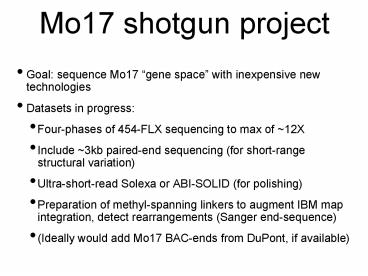Mo17 shotgun project PowerPoint PPT Presentation
1 / 16
Title: Mo17 shotgun project
1
Mo17 shotgun project
- Goal sequence Mo17 gene space with inexpensive
new technologies - Datasets in progress
- Four-phases of 454-FLX sequencing to max of 12X
- Include 3kb paired-end sequencing (for
short-range structural variation) - Ultra-short-read Solexa or ABI-SOLID (for
polishing) - Preparation of methyl-spanning linkers to augment
IBM map integration, detect rearrangements
(Sanger end-sequence) - (Ideally would add Mo17 BAC-ends from DuPont, if
available)
2
Shotgun
- Independent of tiling path
- -Can detect non-repetitive gene space even
within otherwise complex regions that may not be
in tiling path - Disadvantages of short-reads
- -Cant expect to recover repetitive sequences
3
Four Phases of Sequencing Complete in 2007
- Sequencing contract established with 454/Roche.
Four Phases, including collaborative runs at no
cost in P2-4. - Phase I underway (30 FLX runs.) Library QC and
initial assessment of data quality (30 FLX runs).
- 10 FLX runs totaling 1 Gb (0.4X)
- 20 FLX pair runs spanning 12 Gb (5X span in 3kb
inserts) - Assess quality, coverage, contamination,
chimerism, accuracy - Phase II. (80 runs plus 30 runs from Roche, total
110 runs). Rough draft stage. - 40 FLX-pair runs spanning 36 Gb (total 48 Gb10X
span) - 70 FLX runs for 7 Gb (total 8Gb 3.5X sequence)
- Assess rough draft assembly (3 methods), compare
B73, sorghum
4
Phases III and IV
- Phase III (50 runs 20 contributed)
- 20 FLX-pair runs (total spanning cover 20X)
- 50 FLX runs (total 13 Gb sequence 5.5X)
- Draft assembly. Rough annnotation. Assessment
of structural - variation based on 20X clone cover.
Assessment complete by - end of 2007.
- Phase IV (60 runs 30 contributed)
- 90 FLX runs (to reach total 22 Gb 10X)
- Data collection complete by end of 2007.
- Early 08. Final assembly. Integration with MSSL
ends and IBM - map. Proceed to annotation and full analysis.
- Note Later phases may use next FLX release with
longer - read lengths. To be conservative, sequence from
FLX-pair - reads not included in sequence coverage
estimates. - Total sequencing cost for Phase I-IV 1.6M
5
454-FLX reads are typically either mostly masked,
or mostly clean
29 of reads have lt quarter of positions masked
58 of reads have gt 2/3 of positions masked
0 0.5
1.0 Percent masked by over-repd
16mers
6
Mo17 454 unique full length alignments vs. B73
MAGIs show high quality of unique alignments
Residual repeats in MAGIs with multiple hits in
454 data
Unique full alignments
7
SNPs and indels of 454 reads relative to MAGIs
consistent with few variation of Mo17/B73
(combines variation with sequencing errors)
SNPs or indels per base
Frequency of reads
8
Multiple assembly alternate plans
- Divide and conquer
- Reduce 100 million reads to 50K unique gene
- spaces of thousands of reads each (10kb) by
- clustering based on various comparisons
- Plan A De novo clustering of masked reads
- Plan B map to B73, assemble (de novo for
remainder) - Plan C sorghum-assisted
- Use various assemblers to lay-out and produce
- consensus for each cluster (454 assembly team
engaged) - Polish sequence with Solexa or SOLID for
- accuracy
- Link with MSSL pairs, integrate with map
9
Backup analyses vs. B73 reference
- SNP/variation detection by alignment to B73
sequence - -454/Solexa/Solid (various successful models in
other species at JGI, elsewhere) - Structural variation detection via paired-end
placements - -Needs to be tolerant of chimerism rate
- -Model of successful human structural analysis
done with 454 (unpublished)
10
Timeline
- Phase I in progress, complete by end of month.
Analysis to OK phase II 10 days. - Phase II October
- Phase III November
- Phase IV December
- 454 sequencing complete by end of year
11
58 of each BAC is masked by over-represented
16-mers
12
Outreach Dick McCombie
13
Types of Outreach
- Public presentations
- Collaborations
- CSHL DNA Learning Center
14
Public Presentations
15
Collaborations
- The Maize Genetics and Genomics Database.
--Letter - for Carolyn Lawrence-MaizeGDB
- MaizeGDB-web site text, links to data
- Gramene
- EBI Ensembl
- Affymetrix Maize Pilot Expression Array Project
- Optical map
- TWINSCAN
- Vmatch
- Full-Length cDNA Project
16
CSHL DNA Learning Center
http//www.dnalc.org/maize/maize.html

